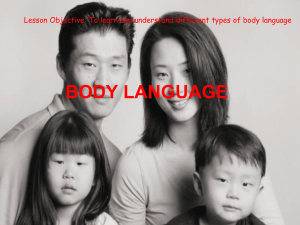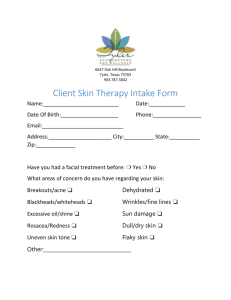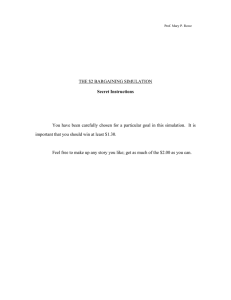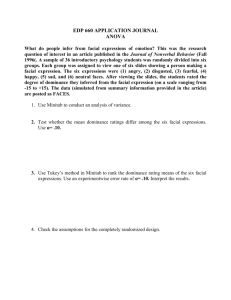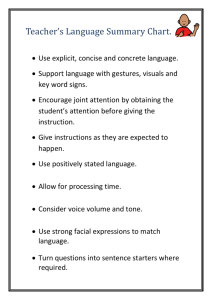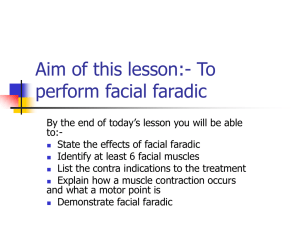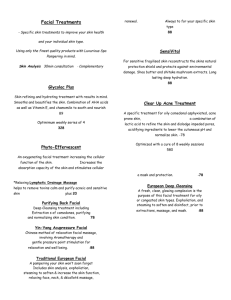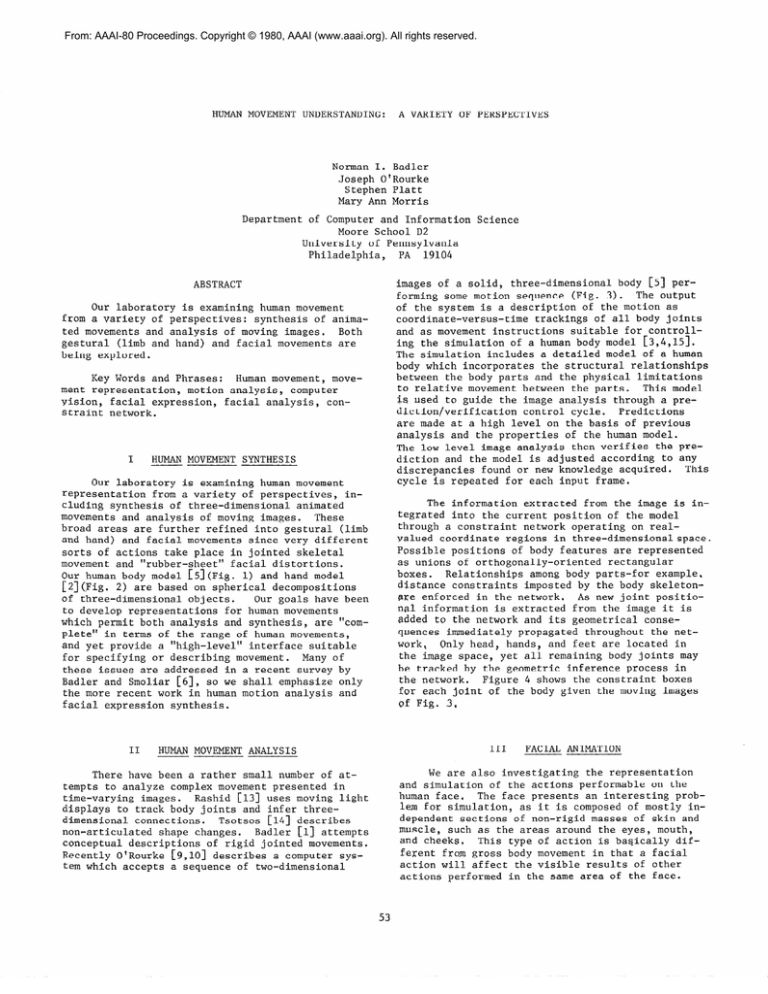
From: AAAI-80 Proceedings. Copyright © 1980, AAAI (www.aaai.org). All rights reserved.
HUMAN MOVEMENT
UNDERSTANDING:
A VARIETY
OF PERSPECTIVES
Norman I. Badler
Joseph O'Rourke
Stephen Platt
Mary Ann Morris
Department
of Computer and Information
Moore School D2
University of Pennsylvania
Philadelphia,
PA
19104
images of a solid, three-dimensional
body [5] performing some motion sequence (Fig. 3). The output
of the system is a description of the motion as
coordinate-versus-time
trackings of all body joints
and as movement instructions
suitable for controlling the simulation of a human body model [3,4,15].
The simulation includes a detailed model of a human
body which incorporates
the structural relationships
between the body parts and the physical limitations
to relative movement between the parts,
This model
is used to guide the image analysis through a prediction/verification
control cycle.
Predictions
are made at a high level on the basis of previous
analysis and the properties of the human model.
The low level image analysis then verifies the prediction and the model is adjusted according to any
This
discrepancies
found or new knowledge acquired.
cycle is repeated for each input frame.
ABSTRACT
Our laboratory is examining human movement
from a variety of perspectives:
synthesis of animated movements and analysis of moving images.
Both
gestural (limb and hand) and facial movements are
being explored.
Key Words and Phrases:
Human movement, movement representation,
motion analysis, computer
vision, facial expression, facial analysis, constraint network.
I
HUMAN
MOVEMENT
SYNTHESIS
Our laboratory is examining human movement
representation
from a variety of perspectives,
including synthesis of three-dimensional
animated
movements and analysis of moving images.
These
broad areas are further refined into gestural (limb
and hand) and facial movements since very different
sorts of actions take place in jointed skeletal
movement and "rubber-sheet"
facial distortions.
Our human body model r5](Fig. 1) and hand model
[2](Fig. 2) are based on spherical decompositions
of three-dimensional
objects.
Our goals have been
to develop representations
for human movements
which permit both analysis and synthesis, are "complete" in terms of the range of human movements,
and yet provide a "high-level"
interface suitable
for specifying or describing movement.
Many of
these issues are addressed in a recent survey by
Badler and Smoliar [6], so we shall emphasize only
the more recent work in human motion analysis and
facial expression synthesis.
II
HUMAN
MOVEMENT
Science
The information extracted from the image is integrated into the current position of the model
through a constraint network operating on realvalued coordinate regions in three-dimensional space.
Possible positions of body features are represented
as unions of orthogonally-oriented
rectangular
Relationships
among body parts-for example,
boxes.
distance constraints
imposted by the body skeletonare enforced in the network.
As new joint positional information is extracted from the image it is
added to the network and its geometrical
consequences immediately propagated throughout the netOnly head, hands, and feet are located in
work,
the image space , yet all remaining body joints may
be tracked by the geometric inference process in
the network.
Figure 4 shows the constraint boxes
for each joint of the body given the moving images
of Fig. 3.
III
ANALYSIS
FACIAL
ANIMATION
We are also investigating
the representation
and simulation of the actions performable on the
human face,
The face presents an interesting problem for simulation, as it is composed of mostly independent sections of non-rigid masses of skin and
muscle, such as the areas around the eyes, mouth,
and cheeks,
This type of action is basically different from gross body movement in that a facial
action will affect the visible results of other
actions performed in the same area of the face.
There have been a rather small number of attempts to analyze complex movement presented in
time-varying
images.
Rashid [13] uses moving light
displays to track body joints and infer threedimensional
connections.
Tsotsos [14] describes
non-articulated
shape changes.
Badler [l] attempts
conceptual descriptions
of rigid jointed movements.
Recently O'Rourke [9,10] describes a computer system which accepts a sequence of two-dimensional
53
Our internal representation
of the face is
based on FACS, the Facial Action Coding System [7].
The system categorizes basic actions performable
and recognizable
(by a human notator) on the face.
It is also easily translated into a state-description of the face, in terms of muscle contractions.
A complete recognition and simulation system for the
face would consist of a camera, computer processing
to obtain an idealized internal representation
of
the action, and a simulation of the action performed on a graphic output device.
Once the camera
image is obtained, analysis is performed to produce
the AU (FACS Action Unit) state of the face.
This
analysis is relatively simple, as it consists of
identifying
the presence/absence
of "features" such
as wrinkles and bulges on the face.
(Note that
this analysis does not require "recognition"
of a
particular face, just good comparison between successive images of the same face.) The current technique under investigation
uses an improved method
of "rubber-sheet"
matching [8].
Each AU effects
only a small set of muscles;
their union gives the
muscle-status
of the face.
The specified muscle
contractions
are then simulated on the face.
REFERENCES
lx1
I:23 Badler,
N.1, and J. O'Rourke.
Representation
of articulable,
quasi-rigid,
three-dimensional
objects,
Proc. Workshop on Representation
of
Three-Dimensional
Objects, Philadelphia,
PA,
May 1979.
13J Badler, N.I., J. O'Rourke, and B. Kaufman.
Special problems in human movement simulation,
Computer Graphics Summer 1980.
The face is represented by a network of points
and interconnecting
arcs (Figs. 5 and 6) 1121.
It
also has a higher level of organization which partitions the network into the skin surface and specific muscles.
(It is this muscle organization
which distinguishes
our work from that of Parke
[XL].)
The skin is a "warped" two-dimensional
surface of points and arcs.
The points represent
the basic surface, while the arcs contain information specific to their locale, such as the elasticity ("stretchiness")
of the skin between the arc's
points.
Stretching the skin (by contracting a muscle) causes first local motion, followed by propagation of the skin distortion.
Muscles are also
points, connected to but beneath the skin.
They
are distinguished
by being the initiation of the
distortion of the skin surface.
An AU is thus merely a set of muscles, with appropriate magnitudes
of
initial force of contraction.
IV
Temporal scene analysis:
ConcepBadler, N.I.
Tech.
tual descriptions
of object movements.
Rep. 80, Dept. of Computer Science, Univ. of
Toronto, Feb. 1975.
PJ
Badler, N.I., J, O'Rourke, S.W. Smoliar, and
L, Weber,
The simulation of human movement by
computer,
Tech. Rep. Dept. of Computer and
Information Science, Univ. of Pennsylvania,
July 1978.
[5J
Badler, N.I., J. O'Rourke, and H. Toltzis.
A
spherical representation
of a human body for
visualizing movement.
IEEE Proceedings
67: 10
(1979) pp. 1397-1403.
Badler, N.I. and Smoliar, S.W.
Digital representations of human movement.
Computing Surveys 11: 1 (1979) pp. 19-38.
Facial
171 Ekman, P. and W. Friesen.
System.
Consulting Psychologists
Alto, CA. 1978.
ActionCoding
Press,Palo
b31 Fischler,M,A.
and R.A. Erschlager.
The representation and matching of pictoral structures.
IEEE Tr. on Computers C-22: 1 (1973).
El
O'Rourke, J.
Image analysis of human motion.
Ph.D. Diss. Dept. of Computer and Information
Science, Univ. of Pennsylvania,
1980.
ho3
O'Rourke, 3, and N.I. Badler.
Human motion
analysis using constraint propagation.
To
appear IEEE-PAM1 November 1980.
IKl
Parke,
Annual
FUTURES
Our research into human movement understanding
has the joint goals of achieving conceptual descriptions of human activities and producing effective animations of three-dimensional
human movement
from formal specification
or notation systems 161.
One application of this effort is in the synthesis
and analysis of American Sign Language.
A prototype synthesizer for ASL is being designed to facilitate experimentation
with human dynamics and
movement variations which have linguistic import
for facial and manual communication.
F.I.
Animation of faces.
Conf. 1972, pp. 451-457.
Proc.
ACM
l-12J Platt, S. Animating facial expressions.
Thesis, Dept. of Computer and Information
Science, Univ. of Pennsylvania,
1980.
1133
MSE
Rashid, R. Lights:
A system for the interpretation of moving light displays.
To
appear IEEE-PAMI, Nov. 1980.
t-143 Tsotsos, J. A framework for visual motion
Ph.D. Diss. Dept. of Computer
analysis.
Science, Univ. of Toronto, 1980.
ACKNOWLEDGEMENTS
[15] Weber, L., S.W. Smoliar, and N.I. Badler.
An
architecture
for the simulation of human movement,
Proc. ACM Annual Conf. 1978, pp. 737745,
The support of NSF Grants MCS76-19464,
MCS7807466, and O'Rourke's IBM Fellowship are gratefully
acknowledged.
54
Simulated
Figure
4.
Constraint
movement
boxes
for mo vements
in Fig.
3.
Figure 7.
Upper porti
muscles;
t
has been pu
right brow.
showing some of th
butline and muscles
55


